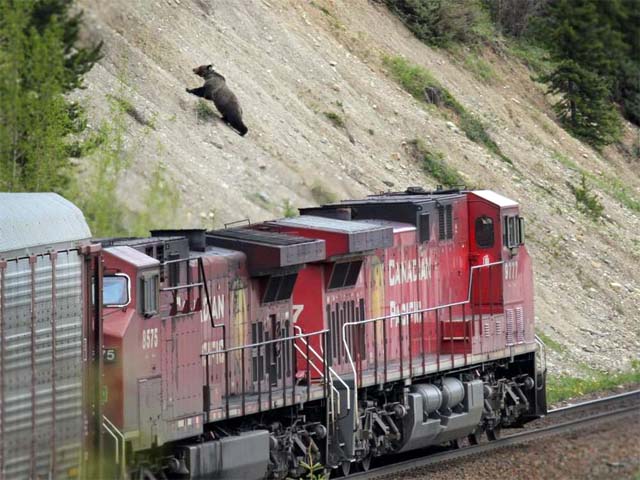
in Spilled Railway Grain
Banff Alberta - After finding elevated levels of contaminants in grain along the railway in Banff and Yoho national parks that may be harmful to
wildlife eating it, researchers suggest a speedier removal of grain and additional monitoring.
The University of Alberta (UofA) study, which came out of the Parks Canada-Canadian Pacific Railway plan to try to reduce grizzly bear deaths on the tracks,
found heavy metals and PAHs (polycyclic aromatic hydrocarbons) in both grain and dandelion samples, foods grizzlies love to eat.
But the research indicated the average concentrations for both heavy metals and PAHs were higher in grain than rail side dandelions, with average
concentrations of heavy metals up to 70 times higher in grain.
Researchers say they also analyzed hair from 20 different grizzly bears, 10 male and 10 female, to test heavy metal concentrations and, while average
concentrations were higher for males than females, it was highly variable among individuals.
"So far this analysis is showing that rail-based forage does contain transportation associated contaminants in both vegetation and grain," said
researcher Sonya Pollock, a PhD student at UofA.
"The elevated levels we're finding in grain may warrant further monitoring and also the prioritization of grain removal."
Pollock said railways contain many pollutants such as metals and PAHs coming from various sources such as material abrasion, machine grease and oil, creosote
treated railway ties, and particulate matter from emissions.
"Animals forage along the railway and so these contaminants can imbed on forage next to the railway, such as train-spilled grain or vegetation growing
along the side of the track," she said.
"This can have health consequences for bears and other wildlife."
While bears are attracted to the tracks to munch on abundant vegetation, and do use the railway as an easy travel route, bears have also long been lured to the
tracks to feast on grain.
Other research has indicated approximately 110 tonnes of grain is spilled or trickled across a 137 kilometre stretch of railway in Banff and Yoho, enough to
feed 50 bears for an entire year.
Researchers collected grain from five sites along the Canadian Pacific mainline, collected decomposing grain when they could, and used two samples of store
bought grain as a reference.
They also collected dandelions along the railway line and further back into the forest for comparison in testing.
Bear hair from 20 individual grizzly bears were also submitted to a lab for testing for heavy metals.
They had location data for GPS collars not only for railroads, but also roads and ski hills.
"We were interested to see if there's any correlations between metal concentration in bears' hair and the amount of railway use or the use of other
anthropogenic features," said Pollock.
"We're not seeing any strong correlation. I also looked at each individual metal and I looked up proximity to roads as well, and ski hills, and we didn't
see any strong or significant correlation between these concentrations."
The study found average concentrations in grain samples were close to standard for cadmium, were more than twice as high for aluminum, and were about three
times as high for lead.
Researchers came up with these results by using federal government standards for monitored metals in complete animal feed.
"We need to be cautious because this threshold is based on complete feed and so we don't know how much necessarily the bears are ingesting," said
Pollock.
"It's also a seasonal exposure, so it's hard to definitively state susceptibility to toxicity, but nonetheless there are indirect effects for consuming
even low levels of these contaminants."
In addition, PAH concentrations were much higher in grain than vegetation growing by the railway line.
Pollock said concentrations of benzo(a)pyrene, a known carcinogen in people, were about three times higher in grain samples than the recommended concentration
in residential soils.
"With PAHs, we found that, on average, we're higher than what's permissible in residential soils," she said.
Salem Woodrow, a spokesperson for CP, said the research regarding the potential for PAH and metal accumulation in grain was completed late in the research
program.
"CP has not had an opportunity for our experts to review in detail," said Woodrow.
"Throughout this whole process CP has maintained close communications with the research team as well as Parks Canada and we want to be able to discuss in
detail certain aspects, such as methodology and reference standards, with our partners before we comment further."
There have been 17 known grizzly bear deaths on the railway in Banff and Yoho since 2000, but that number does not take into account bears that may have been
struck and never found.
Cathy Ellis.
of the Canadian Copyright Modernization Act.



